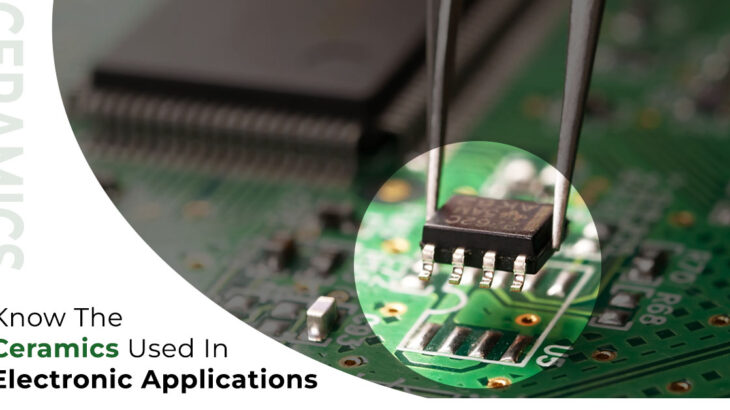
Ceramic materials utilized in the design and development of electronic systems are ubiquitous. Ceramics have been an integral part of human civilization for millennia, with applications ranging from pottery to aerospace engineering. In the realm of electronics, ceramics play a crucial role due to their unique combination of electrical, mechanical, and thermal properties.
Hence, ceramics like Aluminum oxide play a vital role in multilayer ceramic capacitors and resistors by offering insulation and dissipating energy in heat. Ceramic substrates and packaging, which include aluminum oxide and beryllium oxide, provide low dielectric loss, excellent thermal conductivity, and chemical stability. Therefore, read the blog to know the common ceramics used in electronic applications.
Ceramics In Passive Components:
Aluminum oxide has exceptional electrical conductivity and is important in developing multilayer ceramic capacitors (MLCCs) for isolating the electrode of different layers and resistors for heat dissipation. These capacitors are layered with a ceramic dielectric between the two metal layers to store electrical charges.Ceramics are also utilized in inductors, thermistors, and various circuit devices for protection.
Ceramics In Electronics
Piezo-Electrics:
Ferroelectric ceramics are equal to piezoelectric ceramics because of their piezoelectric properties, and are mainly utilized in fabricating piezoelectric devices, highlighting the notable utilization of these substances. Due to their elevated piezoelectric coefficients and mechanical attributes, lead zirconate and barium titanate are preferred for manufacturing.
Insulators:
Ceramic products are used in insulators as they offer
- Minimal dielectric loss
- Low dielectric constant
- High breakdown resistance
- High insulation resistance
- Constant dielectric characteristics under varying frequencies & temperatures.
- Excellent chemical stability & mechanical strength to operate efficiently as insulators.
These products are used in various applications such as spark plugs, ceramic arc tubes, sealed packaging, exposed wires, power cables, coil bobbins, electronic tube holders, supporting brackets, and band switches. These electronic ceramics must fulfill numerous crucial requirements:
Ceramics In ICs & Semiconductors:
IC Substrates:
Ceramic substrates are flat and thin materials that can be used in ICs. Three common ceramic substrate materials are:
- Aluminum nitride (AlN)
- Aluminum oxide (Al2O3)
- Beryllium oxide (BeO)
Ceramic substrates offer benefits like low dielectric constant, high thermal conductivity, chemical stability, and low dielectric loss.
IC Packaging
Some IC circuits developed on silicon chips may use ceramics as they offer excellent hermetic support and electrical insulation.
Semiconductor Manufacturing:
Fused silica, the main ceramic in the semiconductor industry, finds application in:
- Chambers for epitaxial silicon deposition
- Containment vessels for silicon ingots
- Platforms for holding wafers
- Tanks for wet etching
- Tools for processing individual wafers
Alumina, is known for its thermal and electrical insulation properties, is extensively employed in semiconductor wafer processing apparatus.
Electroceramics:
Electroceramics include more than the known varieties of ferrite-based circuit components and permanent magnets for applications. They have low- and high-temperature co-fired ceramics and based substrates. Moreover, electronically conductive ceramics such as lanthanum-doped strontium titanate (SLT), yttrium-doped strontium titanate (SYT),and indium tin oxide (ITO)find utility in thin-film transistors.
Ceramic PCBs:
Ceramic PCBs known for their poor electrical conductivity, are excellent insulators that delay the unrestricted flow of electrical current. These PCBs find application in high-frequency electronics like microwave circuits, radar systems, and RF devices because of their high dielectric constants and low signal loss.
Also, these ceramics offer structural support to LED lighting, improving heat dissipation, increased lifespan and performance. In electronics, ceramic PCBs manage high temperatures and maintain thermal stability.
Glass Ceramics:
Glass-ceramics, employed in electronics, are used in producing display panels for televisions, computers, and mobile devices. By including glass powder into a hard film paste offers metallization to the electronic parts. Also, they are used as glass seals in various applications to safeguard electronic systems from various external factors. Advancements in the developing flexible glasses like organic light-emitting diodes (OLEDs) using ceramics.
The role of ceramics in electronic applications is wide and versatile. Whether it’s improving energy storage and conversion, enhancing data storage capabilities, or enabling the production of high-performance semiconductor devices, ceramics continue to push the boundaries of electronic technology. As we move towards the future, the versatility and adaptability of ceramics will undoubtedly play a crucial role in shaping the next generation of electronic devices, from flexible displays to advanced power electronics. Embracing the potential of ceramics in electronics opens up exciting possibilities for innovation and progress in the digital age.




 +1.585.935.7123
+1.585.935.7123 +91-804-148-6861
+91-804-148-6861